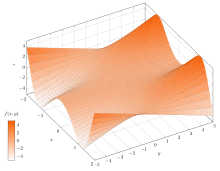Mathematical analysis
![]()
The title of this article is ambiguous. For a description of the philosophy journal Analysis, see Analysis (journal).
Analysis [aˈnaːlyzɪs] (Greek ανάλυσις análysis, German 'Auflösung', Ancient Greek ἀναλύειν analýein 'to resolve') is a branch of mathematics whose foundations were developed independently by Gottfried Wilhelm Leibniz and Isaac Newton as infinitesimal calculus. As an independent branch of mathematics alongside the classical branches of geometry and algebra, analysis has existed since Leonhard Euler.
Fundamental to all calculus are the two bodies 

Subfields of calculus
Analysis has developed into a very general, not clearly definable generic term for a variety of areas. In addition to differential and integral calculus, calculus includes other areas that build on it. These include the theory of ordinary and partial differential equations, the calculus of variations, vector analysis, measure and integration theory, and functional analysis.
The theory of functions also has one of its roots in analysis. Thus the question, which functions are fulfilled by the Cauchy-Riemann differential equations, can be understood as a question of the theory of partial differential equations.
Depending on the view, the fields of harmonic analysis, differential geometry with the subfields differential topology and global analysis, analytic number theory, nonstandard analysis, distribution theory, and microlocal analysis can also be included in whole or in part.
One-dimensional real analysis
Differential calculus
→ Main article: Differential calculus
For a linear function or a straight line
m is the slope and c is the y-axis intercept or ordinate intercept of the line. If one has only 2 points 

For non-linear functions such as 






This quotient is called the difference quotient or mean rate of change. If we now move 

and call this the derivative or differential quotient of f in 






There are also cases where this limit does not exist. That is why the term differentiability was introduced. A function f is called differentiable at the point 

Integral calculus
→ Main article: Integral calculus
The integral calculus deals vividly with the calculation of areas under function graphs. This area can be approximated by a sum of partial areas and passes into the integral in the limit value.
The above sequence converges if f satisfies certain conditions (such as continuity). This illustrative representation (approximation by means of upper and lower sums) corresponds to the so-called Riemann integral, which is taught in school.
In the so-called higher analysis, further integral terms, such as the Lebesgue integral, are also considered.
theorem of integral and differential calculus
→ Main article: Fundamental theorem of calculus
According to the main theorem of calculus, differential calculus and integral calculus behave "inversely" to each other in the following way.
If f is a ![[a,b]](https://www.alegsaonline.com/image/9c4b788fc5c637e26ee98b45f89a5c08c85f7935.svg)

and, if f is additionally 
Therefore, the set of all primitive functions of a function 

Multidimensional real analysis
Many textbooks distinguish between calculus in one dimension and calculus in several dimensions. This differentiation does not affect the basic concepts, but there is greater mathematical variety in multiple dimensions. Multidimensional calculus considers functions 
The notions of norm (as a generalization of magnitude), convergence, continuity, and limits can be easily generalized from one to several dimensions.
Differentiation of functions of several variables is different from one-dimensional differentiation. Important concepts are the directional and partial derivatives, which are derivatives in one direction and in one variable, respectively. Schwarz's theorem establishes when partial and directional derivatives of different directions may be interchanged, respectively. Furthermore, the notion of total differentiation is important. This can be interpreted as the local fitting of a linear mapping to the course of the multidimensional function and is the multidimensional analogue of the (one-dimensional) derivative. The implicit function theorem about the local unique resolution of implicit equations is an important statement of multidimensional calculus and can be understood as a foundation of differential geometry.
In multidimensional analysis, there are different integral terms such as the curve integral, the surface integral, and the space integral. However, from a more abstract point of view of vector analysis, these terms do not differ. To solve these integrals, the transformation theorem as a generalization of the substitution rule and Fubini's theorem, which allows integrals over n-dimensional sets to be transformed into iterated integrals, are of particular importance. The integral theorems from vector analysis by Gauss, Green, and Stokes are also important in multidimensional analysis. They can be understood as a generalization of the main theorem of integral and differential calculus.
Functional Analysis
→ Main article: Functional analysis
Functional analysis is one of the most important branches of analysis. The decisive idea in the development of functional analysis was the development of a coordinate- and dimension-free theory. This brought not only a formal gain, but also made possible the study of functions on infinite-dimensional topological vector spaces. Here not only real analysis and topology are combined, but also methods of algebra play an important role. From important results of functional analysis, such as the theorem of Fréchet-Riesz, central methods for the theory of partial differential equations can be derived. Moreover, functional analysis, especially with spectral theory, is the appropriate framework for the mathematical formulation of quantum mechanics and theories based on it.
Theory of differential equations
→ Main article: Differential equation
A differential equation is an equation that contains an unknown function and derivatives of it. If only ordinary derivatives occur in the equation, the differential equation is called ordinary. An example is the differential equation
of the harmonic oscillator. One speaks of a partial differential equation if partial derivatives occur in the differential equation. An example of this class is the Laplace equation

The aim of the theory of differential equations is to find solutions, methods of solution and other properties of such equations. For ordinary differential equations, a comprehensive theory has been developed by which it is possible to give solutions to given equations, insofar as they exist. Since partial differential equations are more complicated in structure, there is less theory that can be applied to a large class of partial differential equations. Therefore, in the field of partial differential equations, one usually studies only single or smaller classes of equations. To find solutions and properties of such equations, methods from functional analysis and also from distribution theory and microlocal analysis are mainly used. However, there are many partial differential equations for which only little information about the solution structure could be obtained with the help of these analytical methods. An important example of such a complex partial differential equation in physics is the system of Navier-Stokes equations. For these and for other partial differential equations, one tries to find approximate solutions in numerical mathematics.
Function Theory
→ Main article: Function theory
In contrast to real analysis, which deals only with functions of real variables, function theory (also called complex analysis) studies functions of complex variables. The function theory has set itself apart from the real analysis with independent methods and different questions. However, some phenomena of real analysis can only be understood with the help of function theory. The transfer of questions of real analysis into function theory can therefore lead to simplifications.

Gottfried Wilhelm Leibniz

Isaac Newton

Leonhard Euler

Augustin-Louis Cauchy

Bernhard Riemann
Questions and Answers
Q: What is mathematical analysis?
A: Mathematical analysis is a part of mathematics that looks at functions, sequences and series. It provides a rigorous logical foundation to calculus which studies continuous functions, differentiation and integration.
Q: What are some key subfields of mathematical analysis?
A: Some key subfields of mathematical analysis include real analysis, complex analysis, differential equation and functional analysis.
Q: How can mathematical analysis be used in engineering?
A: Mathematical analysis can be used in engineering by examining the useful properties and characteristics of functions, sequences and series.
Q: Who developed most of the basis for mathematical analysis?
A: Gottfried Wilhelm Leibniz and Isaac Newton developed most of the basis for mathematical analysis.
Q: What was the old name for mathematical analysis?
A: The old name for mathematical analysis was "infinitesimal" or "calculus".
Q: How does calculus relate to mathematical anaylsis?
A: Calculus studies continuous functions, differentiation and integration which are all related to the field of mathematics known as Mathematical Analysis.
Search within the encyclopedia









